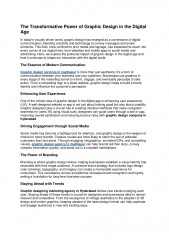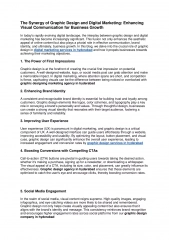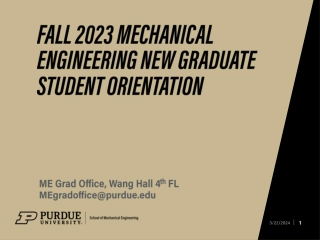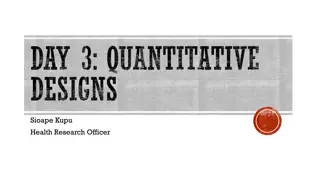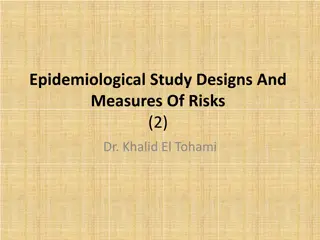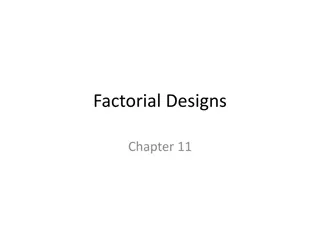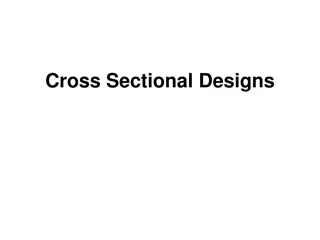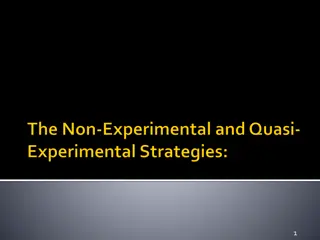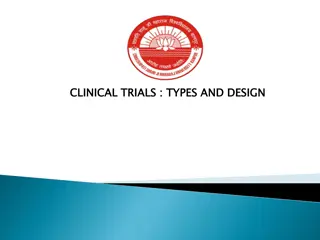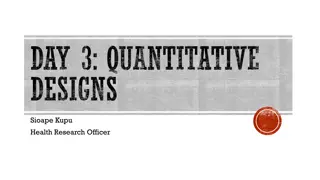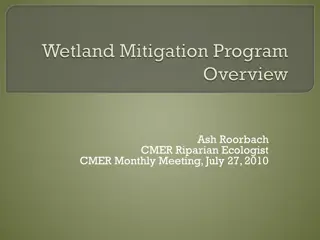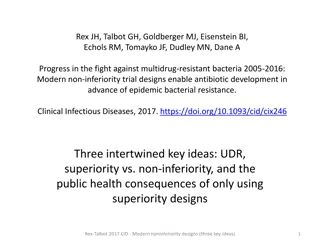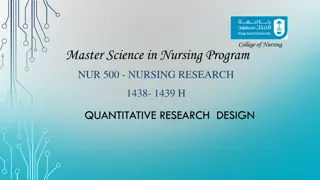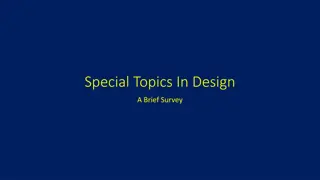
Study Designs and Their Significance in Research
Delve into the realm of study designs to grasp their common types, hierarchy, advantages, and drawbacks. Explore observational and interventional studies while learning about ecological studies, case reports, and more. Gain insights into the nuances of different study designs to make informed selections for research endeavors.
Download Presentation

Please find below an Image/Link to download the presentation.
The content on the website is provided AS IS for your information and personal use only. It may not be sold, licensed, or shared on other websites without obtaining consent from the author. If you encounter any issues during the download, it is possible that the publisher has removed the file from their server.
You are allowed to download the files provided on this website for personal or commercial use, subject to the condition that they are used lawfully. All files are the property of their respective owners.
The content on the website is provided AS IS for your information and personal use only. It may not be sold, licensed, or shared on other websites without obtaining consent from the author.
E N D
Presentation Transcript
Objectives To learn the common study designs. To learn the hierarchy of study designs. To learn the advantages and disadvantages of study designs. To be able to select a study designs.
Introduction Interested in Exposure, and/or Eg. smoking, medicine, risk factors, etc. Outcome Eg. cancer, cure, disease, etc. Outcome Exposure
Introduction Observational studies Interventional studies
Observational Studies 1. Ecological studies 2. Case report 3. Case series 4. Crossed sectional studies 5. Case control 6. Cohort study
1. Ecological Study Focuses on the comparison of groups or aggregate data, rather than individuals Quick, inexpensive Help in formulating hypothesis Disadvantages Inability to link exposure with disease (ecological fallacy) Inability to control for confounding
Ecological Study Eg. Per capita smoking in different countries and cancer rate per 100,000 adults 140 120 100 80 60 40 CANCER 20 20 40 60 80 100 120 140 SMOKING
2. Case Report Documenting rare / novel observation. May indicate a new link between exposure and outcome. Disadvantages It may occur by chance Single case
Case Report BMJ Case Reports 2014; doi:10.1136/bcr-2014-204986 Green urine in a postoperative patient An 85- year-old man underwent reversal of loop ileostomy. The integrity of the anastomosis was tested by an injection of methylene blue into the bowel lumen. Postoperatively the patient voided green urine and alarmed the nursing staff and junior duty doctor. Routine microscopic examination and culture of urine revealed no abnormality. Liver function test and full blood count was also normal. This discolouration of urine resolved spontaneously in the next few days.
3. Case Series Similar with case report but observe more cases. To document potential link between an exposure and outcome. Disadvantages It may occur by chance Few cases Absence of control
Case Series According to previous example, how would you imagine a case series to be? Collection of case reports, reporting methylene blue causing green urine. Eg. 10 case reports, and compile them into a case series.
4. Cross-sectional Study Data collection on exposure and outcome are conducted at the same time. Snap shot of the studied population. Descriptive: Prevalence of cervical cancer Analytical: Association of risk factors (ie. age, SES) and presence of cervical cancer Cheap and quick. Able to study multiple risk factors and outcomes at the same time. No loss to follow-up
Cross-sectional Study Disadvantage Unable to determine causality (cause and effect) Not suitable for rare exposure Unable to establish temporal relationship (ie. alcohol consumption and depression) Outcome Exposure
5. Case Control Study Relatively cheap and quick Can investigate many exposures Suitable for rare diseases No loss to follow-up Study start at outcome Outcome Exposure
Study start at outcome Exposed Disease Non exposed Exposed Non Disease Non Exposed
Case Control Study Disadvantage Selection bias Information bias Not suitable for rare exposures
6. Cohort Study Useful for rare exposure Study multiple outcomes with single exposure Temporal relationship can be established Risk of measurement bias can be minimized Study start at exposure Outcome Exposure
Disease Exposed Non disease Follow up Study start at exposure Disease Non exposed Non disease
Cohort Study Disadvantages: Not suitable for rare diseases Expensive Time consuming Loss to follow-up bias problem
Observational Studies 1. Case report 2. Case series 3. Ecological studies 4. Crossed sectional studies 5. Case control 6. Cohort study
Qualitative Studies Exploratory, Flexible, Complex Authors and world perspective Common categories: Phenomenology Grounded theory Ethnography Case study
Qualitative Studies Common methodology: Interview Individual Focus group Semi-structured, structured Observation Individual Group Location Document analysis
Qualitative Studies How has the meaning and practice of informed consent in research changed over the last 35 years? Miller T and Boulton M (2007) Changing constructions of informed consent: Qualitative research and complex social worlds Social Science and Medicine 65 (11) 2199-2211. Factors that help injecting drug users to access and benefit from services: A qualitative study Substance Abuse Treatment, Prevention and Policy 2 (31)
Introduction Observational studies Interventional studies
Interventional Studies Randomized controlled trials True experiment Randomization Confounder distribution Minimize bias Blinding Controlled
Interventional Studies Randomization (equal chance) Toss of coin Computer generated random number Ms Excel STATA SPSS IVRS
Interventional Studies Blinding Single / Double Participant / Investigator Concealment of randomization Double dummy Assessor and applicator
Cured New treatment Not cured Population Randomization Cured Standard treatment Not cured Study start at exposure outcome
Interventional Studies Disadvantages Ethical issues Expensive Time consuming Need strong justification
Hierarchy of Study Designs Systematic review and meta analysis of RCTs RCTs Cohort studies Case control studies Level of evidence Cross sectional studies Case studies Ideas, expert opinions, editorials Anecdotal
Features ECOLOGICAL EXPERIMENTAL COHORT CASE CONTROL CROSS SECTIONAL Observational Outcome and study factor studied simultaneously Study Type Features Descriptive Aggregate measures Experimental Controlled exposure by experimenter Observational E/not E known for all participants Followed up over a long time period Observational Case chosen incident or prevalent and then assessed for study factor Controls often matched Prevalent or incident cases Control population controls preferred Backward (incident) Non (prevalent) Frequent exposure, Rare outcomes Sampling None measures entire populations eg. countries Often convenient samples (eg. hospital settings) Diverse, large Ideally a random sample of the target population Directionality Non-directional Always forward Always forward Non or backward Used when Establishing association in summary statistics For therapeutic or preventive assessment Exposure rare, Outcome frequent Retrospective for rare disease, long induction Outcome and exposure frequent, Study factor not changing over time, Incidence can be established elsewhere.
Features ECOLOGICAL EXPERIMENTAL COHORT CASE CONTROL CROSS SECTIONAL Not possible Determining Causality Strength of study Not possible +++ ++ + Low as not at individual level MOST POWERFUL Most powerful Next most powerful observational study Defined by outcome, unable to look at multiple effects of study factor Less in time and money cf cohort Selection bias matching controls Information bias Recall bias, poor records Matching to control for strong confounders, collect data on all potential confounders Weakest observational study but useful for prevalence. Can t use for rare outcomes, diseases with short durations. observational study Problems Ecological fallacy Volunteerism, compliance Loss of participants Cost Low, if data available Information bias Expensive High and time consuming Selection bias dropouts Information bias Recall if retrospective Low Major Potential Bias Selection bias, Information bias Selection bias Information Recall bias Controlling for confounding Randomisation Check it worked Collect data on all potential confounders Collect data on all potential confounders Collect data on all potential confounders.
How do we select? Research questions Ethical considerations Resources
Case Scenario 1 Wilm s tumor is a kidney cancer that affects children very early in life. It is more common in West Africa than most parts of the world. The reasons for this are obscure. The fact that most affected children have the disease at birth, or soon after, suggests that the cause of the cancer may act in utero. You wish to design a study to generate hypotheses about the possible exposures in utero that could lead to Wilm s tumor.
Case Scenario 2 Vitamin E is known as an intracellular antioxidant that might protect against cancer, but studies on animals and humans have yielded somewhat conflicting results. Select a study design to examine the effect of vitamin E on the risk of cancer.
Case Scenario 3 An epidemiology graduate student finds evidence in the literature that childhood sunlight exposure may affect adult breast cancer risk. Select a study design to explore this hypothesis
Case Study An exploratory study of the effect of mahjong on the cognitive functioning of persons with dementia Sheung-Tak Cheng, Alfred C. M. Chan and Edwin C. S. Yu INTERNATIONAL JOURNAL OF GERIATRIC PSYCHIATRY Int J Geriatr Psychiatry 2006; 21: 611 617.
References Bonita R, Beaglehole R, Kjellstr m T. Basic Epidemiology 2 ed. Geneva: World Health Organization; 2006. Rothman KJ, Greenland S. Causation and causal inference in epidemiology. American journal of public health 2005;95 Suppl 1:S144. Gordis L., Epidemiology 4th ed. Philadelphia: Saunders Elsevier; 2009. Mason J (2002) Qualitative Researching (2nd edn) London: Sage Publications.
Acknowledgment Acknowledgment to Chew CK for preparation of the core contents of this presentation.
Dear CK, I m just summarising some suggestions given by the other speakers regarding your topic on study design. Also, as the actual GPCR course has increased to 2.5 days, the slot for Study design has been increased to 1.5 hours. So kindly amend the contents for the 1.5 hours of lecture ya. The following are the suggestions of information to be added into your powerpoint: 1. To state on randomisation method: eg: toss of coin if only 2 study groups, using sealed envelope, generate of random tables. Etc 2. To state on how to do blinding 3. To include study design for Qualitative studies, methods and pros and cons of different methods: ie: face-to-face interview, focus group etc 4. To provide a case study using a published article and further discuss or critique on the study design. The dateline for submission of new slides is by 10/11/14(Monday). Also, please add in an acknowledgement slide for yourself in the powerpoint. Do send it to lai at laiwh@crc.gov.my


